| Содержание |
| Reading messages Creating new messages Settings |
 Mail
Mail
| Расположение в Deskbar: | ||
| Расположение в Tracker: | /boot/system/apps/Mail | |
| Настройки хранятся по адресу: | ~/config/settings/Mail/ ~/config/settings/Mail/Menu Links/ - Objects put here appear in the mailbox' context menu ~/config/settings/Mail/signatures/ - Location to store signatures ~/config/settings/Mail/status/ - Location to store custom statuses |
Mail is Haiku's default viewer and editor of emails. It has nothing to do with the actual fetching and sending of mails, which is done by the mail_daemon and can be configured via the E-mail preferences.
This page is a general overview of the application Mail. For more information how email in Haiku works, refer to the Workshop on managing email.
 Reading messages
Reading messages
You double-click an email file to open it in Mail. The interface is quite simple:

A menu and optional tool bar on top, with an area of the interesting attributes of a mail (to, from, subject, date) below that, and then the actual body of the mail. If the mail appears with strange characters or empty, try to change the in the menu.
If there are files attached to an email, they are listed at the end of the message. A right-click on one opens a context menu to or . You can also drag & drop directly to the Desktop or another Tracker window.
Most of the menu and tool bar items are pretty self-explaining, so we'll concentrate just on the highlights.
 File
File
When you close the window of a new mail, its status is normally switched from "New" to "Read". But you can set other statuses as well, by choosing from the submenu. There you'll also find the option to create your own custom statuses, which are saved under ~/config/settings/Mail/status/.
 Edit
Edit
Here you'll find an item to open Mail's (see below) and a shortcut to manage your , which will open the E-mail preference panel.
 View
View
You'll only seldomly need these two items, if at all:
| ALT H | Shows the complete header of a mail, in case you need to track down the path of your mail, for example. | ||
| Displays a mail in its raw state, i.e. with all its control characters and without Mail's coloring of quotes or URLs, for example.. |
 Message
Message
The different options to reply to a mail may need a bit of explanation.
| ALT R | The standard reply to the server that has sent the mail to you. NOTE: In case of a mailing list post, this normally replies back to the mailing list, not just the person that wrote the post! | ||
| OPT ALT R | This on the other hand, sends directly and only to the person listed in the "From" attribute. | ||
| SHIFT ALT R | Replies to the original sender plus all other (cc'ed) recipients of the original mail. |
The items to , and are again pretty self-explaining.
When you've opened an email from a Tracker or query result window, and will move to the previous/next email in the list.
collects all email addresses from the header and the actual email body in a submenu. Choosing an address will open the People application in order to complete and save the contact information.
 Queries
Queries
This menu holds queries that show all mails related to the currently open mail. Selecting , or opens a query that lists all corresponding mails:
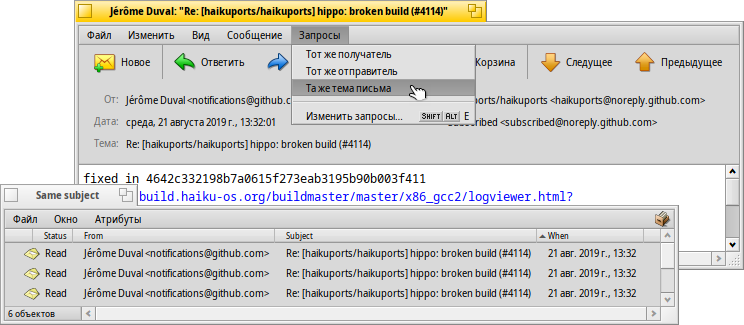
 Creating new messages
Creating new messages
A new email is created by invoking of the menu or the corresponding icon from the tool bar of an open email. Or you just start the Mail application or choose from the context menu of the mailbox icon in the Deskbar.
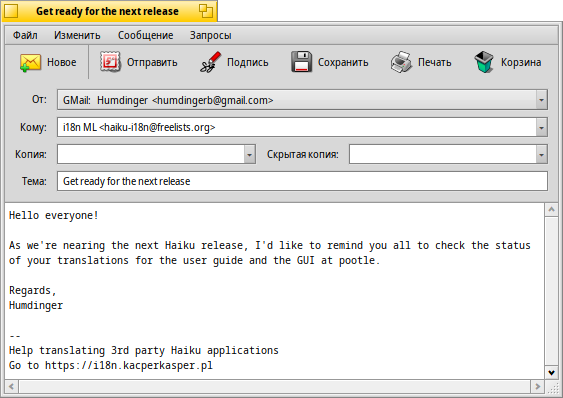
The window is pretty similar to the one when reading mails. The menu and tool bar items are slightly different and the text boxes have to be filled with the recipient's email address, subject and so on, of course.
is short for the anachronistic term "carbon copy" and results in copies of your mail being sent to the listed people. The difference to just listing a buch of addresses in the "To" field is, that you don't directly address the cc'ed people, thereby signaling that you probably don't expect an answer of them.
means "blind carbon copy" which does practically the same as "Cc", but hides the recipients from each other.
You can enter several recipients by separating their addresses with a comma. , , and are pop-up menus. They contain all email addresses on your system found by a query for People files. Their "Group" attribute will sort them in corresponding submenus.
Again, we'll focus on the more interesting features in the menus.
 File
File
With you can store your work so far and come back to it later. To load it again, choose it from the submenu that will list the result of a query for all mails with the status "Draft".
 Edit
Edit
and or their respective shortcuts ALT / - are used to add/remove a level of quoting by adjusting the number of ">" symbols in front of quoted lines. Just select some text in all the lines you want un/quoted and invoke the menu item.
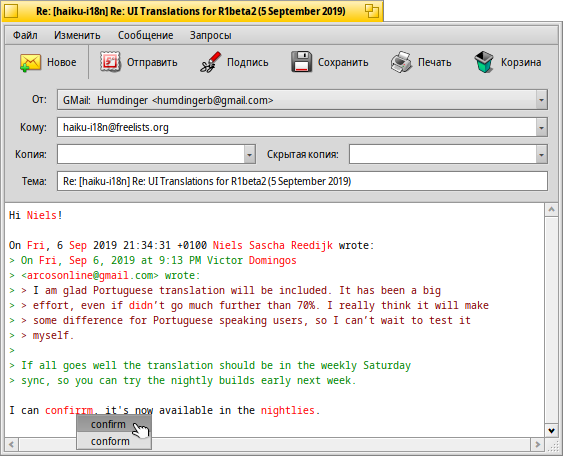
currently only offers corrections of English texts by marking wrong or unknown words red and showing them in italic. Right-clicking such a word opens a context menu offering suggestions to correct the word or to it to the accepted vocabulary.
Then, there are again the items to open Mail's (see below) and a shortcut to managing your , which will open the E-mail preference panel.
 Message
Message
With you can add predefined texts to the end of your mail. From its submenu you can choose a specific or one.
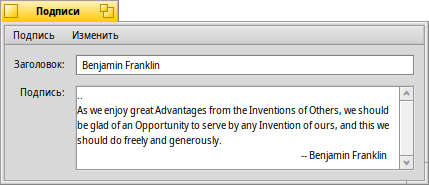
You create new or edit existing signatures with , which will open a window where you enter the text itself and the title of your new sig. There, in the menu, you find items to a specific signature or or the currently loaded one, Signatures should be saved in ~/config/settings/Mail/signatures.
Use and to add/remove files as enclosures. You can also drag & drop files from a Tracker window. With text files you have to be careful not to drop them in the email body, or they'll get pasted as text instead.
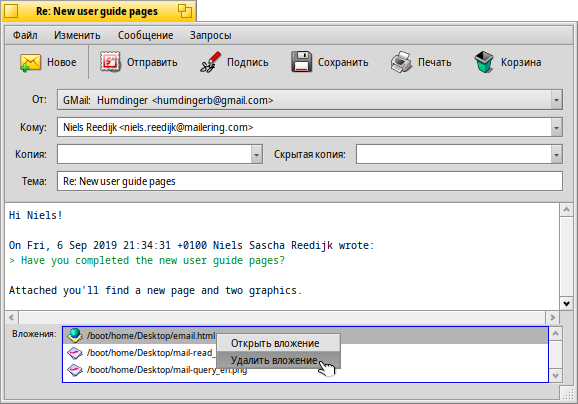
File attachments are listed below the email body. You can remove a file by invoking a context menu or by selecting it and pressing DEL.
 Queries
Queries
As when reading mails, this menu holds queries that show all mails related to the one you are currently composing. Selecting , or opens a query that lists all matching mails.
 Settings
Settings
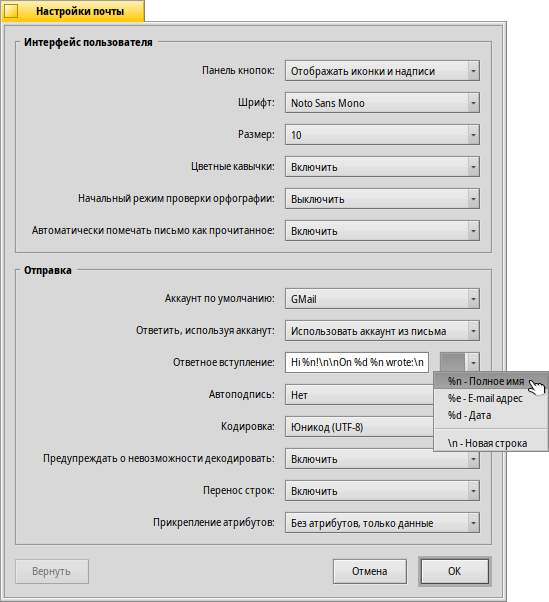
Mail's settings come in two parts:
 User interface
User interface
| Options to show labels under the icons or hide the tool bar completely. | ||
| Sets the type of font used for the email text. | ||
| Sets the font size. | ||
| Colors different levels of quotation. | ||
| Turns the spell checker on/off on startup. | ||
| If you close an email with the Status "New", you can have it automatically marked as "Read". |
 Mailing
Mailing
| If you have several email accounts, this specifies which to use by default when creating a new message. | ||
| When you reply to a mail, you can either always set in the pop-up menu above, or use the , which will send the mail from the same account that received the original message. | ||
This is inserted before the quoted text in your reply. You can use various variables from the pop-up menu next to the text field. Example: "Hello %n!\n\nOn %d you wrote:\n" produces this:
Hello Dr. Hawking! On Mon, 18 Jan 1998 02:55:16 +0800 you wrote: > so thanks again for the inspiration concerning the cosmological constant. > ...and the rest of the quoted text following... | ||
| Adds a signature automatically to the end of the mail. | ||
| Sets the default encoding. | ||
| If your mail contains characters that can't be encoded with the currently set encoding method, you can turn on being warned about that. That gives you the opportunity to change the encoding before sending. Otherwise unencodable characters are replaced by rectangle symbols. | ||
| Inserts line-breaks every 76 characters which makes mails easier to read. | ||
| You can choose to send BFS' attributes of a file alongside the attachments. This is nice for other Haiku users, as they'll get a "complete" file (think artist, album, title attributes of MP3 files), but may cause confusion (or even suspicion) with others, who will wonder what the additional "BeOS Attributes" attachment might be… Should you opt not to send attributes with your attachments, remember to zip up your files before you send them or you'll strip away BFS attributes. |